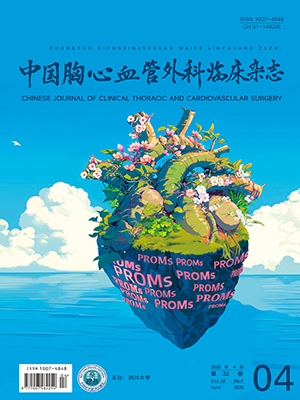Objective To investigate the risk factors for postoperative gastrointestinal bleeding (GIB) in patients with type A aortic dissection, and further discuss its prevention and treatment. Methods The clinical data of patients with type A aortic dissection admitted to the Department of Cardiovascular Surgery of the First Affiliated Hospital of Naval Medical University from 2017 to 2021 were retrospectively analyzed. Patients were divided into a GIB group and a non-GIB group based on the presence of GIB after surgery. The variables with statistical differences between two groups in univariate analysis were included into a multivariate logistic regression model to analyze the risk factors for postoperative GIB in patients with type A aortic dissection. Results There were 18 patients in the GIB group including 12 males and 6 females, aged 60.11±10.63 years, while 511 patients in the non-GIB group including 384 males and 127 females, aged 49.81±12.88 years. In the univariate analysis, there were statistical differences in age, preoperative percutaneous arterial oxygen saturation (SpO2)<95%, intraoperative circulatory arrest time, postoperative low cardiac output syndrome, ventilator withdrawal time>72 hours, postoperative FiO2≥50%, continuous renal replacement therapy (CRRT) rate, extracorporeal membrane oxygenation (ECMO) rate, infection rate, length of hospital stay and ICU stay, and in-hospital mortality (all P<0.05). In the multivariate logistic regression analysis, preoperative SpO2<95% (OR=10.845, 95%CI 2.038-57.703), ventilator withdrawal time>72 hours (OR=0.004, 95%CI 0.001-0.016), CRRT (OR=6.822, 95%CI 1.778-26.171) were risk factors for postoperative GIB in patients (P≤0.005). In the intra-group analysis of GIB, non-occlusive mesenteric ischemia (NOMI) accounted for 38.9% (7/18) and was the main disease type for postoperative GIB in patients with type A aortic dissection. Conclusion In addition to patients with entrapment involving the superior mesenteric artery who are prone to postoperative GIB, preoperative SpO2<95%, ventilator withdrawal time>72 hours, and CRRT are independent risk factors for postoperative GIB in patients with type A aortic dissection. NOMI is a major disease category for GIB, and timely diagnosis and aggressive treatment are effective ways to reduce mortality. Awareness of its risk factors and treatment are also ways to reduce its incidence.
Citation:
CHENG Hao, LI Bailing, TANG Yangfeng, HAN Lin, XU Zhiyun, ZHOU Wei. Risk factors for gastrointestinal bleeding after type A aortic dissection surgery: A retrospective cohort study. Chinese Journal of Clinical Thoracic and Cardiovascular Surgery, 2024, 31(4): 531-537. doi: 10.7507/1007-4848.202207022
Copy
Copyright © the editorial department of Chinese Journal of Clinical Thoracic and Cardiovascular Surgery of West China Medical Publisher. All rights reserved
| 1. |
Kassahun WT, Schulz T, Richter O, et al. Unchanged high mortality rates from acute occlusive intestinal ischemia: Six year review. Langenbecks Arch Surg, 2008, 393(2): 163-171.
|
| 2. |
Clair DG, Beach JM. Mesenteric ischemia. N Engl J Med, 2016, 374(10): 959-968.
|
| 3. |
Trompeter M, Brazda T, Remy CT, et al. Non-occlusive mesenteric ischemia: Etiology, diagnosis, and interventional therapy. Eur Radiol, 2002, 12(5): 1179-1187.
|
| 4. |
张浩阳. 单中心Stanford A型主动脉夹层外科治疗后消化道出血的回顾性研究. 华中科技大学, 2020.
|
| 5. |
Yang B, Rosati CM, Norton EL, et al. Endovascular fenestration/stenting first followed by delayed open aortic repair for acute type A aortic dissection with malperfusion syndrome. Circulation, 2018, 138(19): 2091-2103.
|
| 6. |
Eugenio N, Carlo S, Massimo M, et al. Nonocclusive intestinal ischemia in patients with acute aortic dissection. J Vasc Surg, 2002, 36(4): 738-745.
|
| 7. |
Verdot P, Calame P, Winiszewski H, et al. Diagnostic performance of CT for the detection of transmural bowel necrosis in non-occlusive mesenteric ischemia. Eur Radiol, 2021, 31(9): 6835-6845.
|
| 8. |
Bourcier S, Oudjit A, Goudard G, et al. Diagnosis of non-occlusive acute mesenteric ischemia in the intensive care unit. Ann Intensive Care, 2016, 6(1): 112.
|
| 9. |
Endo A, Saida F, Mochida Y, et al. Planned versus on-demand relaparotomy strategy in initial surgery for non-occlusive mesenteric ischemia. J Gastrointest Surg, 2021, 25(7): 1837-1846.
|
| 10. |
Cocorullo G, Mirabella A, Falco N, et al. An investigation of bedside laparoscopy in the ICU for cases of non-occlusive mesenteric ischemia. World J Emerg Surg, 2017, 12: 4.
|
| 11. |
Krawiec F, Maitland A, Duan Q, et al. Duodenal ulcers are a major cause of gastrointestinal bleeding after cardiac surgery. J Thorac Cardiovasc Surg, 2017, 154(1): 181-188.
|
- 1. Kassahun WT, Schulz T, Richter O, et al. Unchanged high mortality rates from acute occlusive intestinal ischemia: Six year review. Langenbecks Arch Surg, 2008, 393(2): 163-171.
- 2. Clair DG, Beach JM. Mesenteric ischemia. N Engl J Med, 2016, 374(10): 959-968.
- 3. Trompeter M, Brazda T, Remy CT, et al. Non-occlusive mesenteric ischemia: Etiology, diagnosis, and interventional therapy. Eur Radiol, 2002, 12(5): 1179-1187.
- 4. 张浩阳. 单中心Stanford A型主动脉夹层外科治疗后消化道出血的回顾性研究. 华中科技大学, 2020.
- 5. Yang B, Rosati CM, Norton EL, et al. Endovascular fenestration/stenting first followed by delayed open aortic repair for acute type A aortic dissection with malperfusion syndrome. Circulation, 2018, 138(19): 2091-2103.
- 6. Eugenio N, Carlo S, Massimo M, et al. Nonocclusive intestinal ischemia in patients with acute aortic dissection. J Vasc Surg, 2002, 36(4): 738-745.
- 7. Verdot P, Calame P, Winiszewski H, et al. Diagnostic performance of CT for the detection of transmural bowel necrosis in non-occlusive mesenteric ischemia. Eur Radiol, 2021, 31(9): 6835-6845.
- 8. Bourcier S, Oudjit A, Goudard G, et al. Diagnosis of non-occlusive acute mesenteric ischemia in the intensive care unit. Ann Intensive Care, 2016, 6(1): 112.
- 9. Endo A, Saida F, Mochida Y, et al. Planned versus on-demand relaparotomy strategy in initial surgery for non-occlusive mesenteric ischemia. J Gastrointest Surg, 2021, 25(7): 1837-1846.
- 10. Cocorullo G, Mirabella A, Falco N, et al. An investigation of bedside laparoscopy in the ICU for cases of non-occlusive mesenteric ischemia. World J Emerg Surg, 2017, 12: 4.
- 11. Krawiec F, Maitland A, Duan Q, et al. Duodenal ulcers are a major cause of gastrointestinal bleeding after cardiac surgery. J Thorac Cardiovasc Surg, 2017, 154(1): 181-188.
Journal type citation(1)
| 1. | 高鑫,王铄链,许帅,马文文,徐子昂,胡尕伟,李庆新. 食管癌新辅助治疗疗效评价的网状Meta分析. 中国胸心血管外科临床杂志. 2024(07): 1035-1042 .  View this site View this site | |
Other types of references(2)
| 1. | 陈良亮. 联合术前营养状态及炎症指标情况对食管癌术后患者预后的预测价值及应用研究[D]. 扬州大学. 2022.  Baidu Scholar Baidu Scholar | |
| 2. | 高鑫. 食管癌新辅助治疗疗效评价的网状Meta分析[D]. 宁夏医科大学. 2023.  Baidu Scholar Baidu Scholar | |





 View this site
View this site